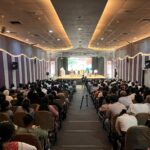Savarkar Flame Illuminates Tales of Unsung Heroes
- By : Anirban Ganguly
- Category : Articles
While lighting the Savarkar Flame in the precincts of the Cellular Jail last week, BJP president Amit Shah had said the flame would serve as an inspiring reminder for us, of all those valiant revolutionaries who smilingly faced the gallows in their quest for India’s freedom. This act of igniting the flame and restoring the dignity of Veer Savarkar’s memory and contribution to India’s struggle for independence was an act of gratitude, symbolising our gratefulness to all those countless revolutionaries who perished either in the hell-hole of Kaala Pani or rotted in British jails often enduring the most inhuman torture.
The Congress’s Mani Shankar Aiyar had desecrated Savarkar’s memory in 2004 by bringing down the commemorative plaque installed in his memory at the Cellular Jail. Aiyar displayed his ignorance of Savarkar’s contribution and demonstrated how his own life-long and often irrational worship of one political dynasty had benumbed his sense of history and of patriotism. In his desecration of Savarkar’s plaque, Aiyar displayed a disrespect for the entire fraternity of revolutionaries who had pursued a line of political action which was different from the one espoused by Mahatma Gandhi but which also had its legitimate and undeniable contribution to the struggle for our national emancipation. Shah’s act of setting alight the altar restored the dignity and cleansed the memorial of that act of desecration. Aiyar’s political party, including the first family that runs it, kept silent throughout this period in which he went about insulting the memory of Savarkar, ignoring the fact that he was one of those revolutionaries to have suffered most at the hands of the British imperialists. Such is the political hatred that Savarkar still inspires in a certain political quarter in this country.
The dimension of revolution in our struggle for freedom is often neglected or ignored. Also ignored are those countless revolutionary nationalists, who in the prime of their youth, decided to undertake a life of struggle, of privation and of sacrifice in order to pursue their dream of seeing India free—a dream that was often laughed at or rejected as a vain chimera. Our system is so habituated to dynastic perpetuation that it has hardly the time or inclination to facilitate or encourage research and documentation of these forgotten heroes.
In the last six decades, no thought has been given to the fact that one could erect a grand museum and memorial for freedom fighters, especially the revolutionaries who died a lonely and often tortuous death. Masterda Surya Sen, for example, was tortured to death, his nails pulled out, his bones broken and the body shoved in a sack and dumped in the depths of the Bay of Bengal; the mighty and vibrant Ullaskar Dutta went insane, unable to bear the extreme tortures at the Cellular Jail while the valiant Indu Bhushan Roy committed suicide after being battered and pulped in the same confines. Stories such as these lie hidden, some half-told, some obliterated and yet others blanketed, and wait to be re-discovered and widely narrated through our curriculums, commemorative publications and public discourse. It brings a freshness to see the trend gradually coming into circulation with the decision to commemorate our unsung heroes who resisted foreign aggression and to perpetuate their memory through courses and programmes.
Even the valiant stories of the phase preceding the war of 1857 need to be told in detail, since they reflect the heroic Indian nature. The saga of Maruthu Pandiyar brothers of Sivaganga, for example, needs to be recounted widely.
The Savarkar Flame, thus, gives hope that the revolutionary saga of our freedom struggle will at last find a full and true narrative.

















